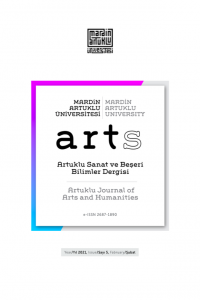Abstract
do it is an open model of exhibition that has been evolving and developing since it’s conception in 1993 by curator Hans Ulrich Obrist, Christian Boltanski and Bertrand Lavier. The exhibitions are generated through the instructions by various artists, compiled in booklets. Brought forth through the questioning of limits of exhibition practices and contemplation of alternatives to the circulation of art, do it exhibitions focus on the interaction between the original artists and the artists/ spectators applying the instructions. Aiming to emphasise diversity in the face of homogenizing effects of globalization, do it claims to have a structure that learns and grows, as opposed to the traditional exhibitioning models which impose information. Deriving from the idea of “instruction” that began with Duchamp and was frequently used by the art movements of the 60’s and 70’s, the project refers to the Neo-Avandgarde spirit of the contemporary world. In this paper, we examine the structure of do it as a model of exhibitioning that provides a unique alternative to traditional exhibitioning methods. To this end, we examine the origins of do it. We observe the motivation behind the expansive-transformative structure of the exhibitions and touch on the art historical context of the idea behind the project, determining the ways in which do it diverges from its predecessors.
References
- Altshuler, B. J. (1997). "Art by Instruction and the Pre-History of do it. Do it Compendium. New York: Independent Curators Incorporated.
- Artspaces,(2017, 14 Temmuz). "It’s The Idea That’s Important": Christian Boltanski Thinks Art Is Like a Musical Score that Anyone Can Play [Röportaj]. https://www.artspace.com/magazine/art_101/book_report/christian-boltanski-phaidon-54886. Erişim Tarihi: 11 Kasım 2020
- Cabanne, P. (1979). Dialogues With Marcel Duchamp By Pierre Cabanne. Londra: Da Capo Press.
- Cashdan, M. (2013, 3 Temmuz). “do it” with Hans Ulrich Obrist: The World’s Busiest Curator Talks About the Latest Iteration of his 20-Year Project [Röportaj]. Artsy. https://www.artsy.net/article/editorial-do-it-with-hans-ulrich-obrist-the. Erişim Tarihi: 7 Aralık 2020
- Curatorsintl.org. https://curatorsintl.org/special-projects/do-it/about. Erişim Tarihi: 8 Kasım 2020
- Feinstein, L. (2013, 18 Haziran). Do it: The Compendium by Hans Ulrich Obrist. Dwell. https://www.dwell.com/article/do-it-the-compendium-by-hans-ulrich-obrist-2f8e64fa. Erişim Tarihi: 11 Aralık 2020
- Fleck, R. (1996). Scores for Installations: Conversation with Robert Fleck [Röportaj]. Curatorsintl. https://curatorsintl.org/posts/scores-for-installations-conversation-with-robert-fleck. Erişim Tarihi: 7 Kasım 2020
- Hu, Y. (2007, 13 Kasım). Why do it Chinese Version? Hu Yuanxing interviews Hans Ulrich Obrist and Hu Fang [Röportaj]. Vitaminecreativespace. http://vitamincreativespace.art/en/?book=do-it. Erişim Tarihi: 8 Aralık 2020
- Nauman, M. F., Duchamp, M. (1982). Affectueusement, Marcel: Ten Letters from Marcel Duchamp to Suzanne Duchamp and Jean Crotti. Archives of American Art Journal, 1982, 22 (4), 2-19
- Obrist, H. U. (2000). How We Do What We Do. And How We Don’t. Paula Marincola (Ed.), Curatıng Now: Imagınatıve Practıce/Publıc Responsıbılıty Sempozyumu kitabı içinde (s. 3-45).Pennsylvania: Pennsylvania Academy of the Fine Arts.
- Walls, S. C. (2015, 27 Mayıs). Peel, Peek, Touch, Rub: Reading Yoko Ono’s “Grapefruit”. Newyorker. https://www.newyorker.com/books/page-turner/peel-peek-touch-rub-reading-yoko-onos-grapefruit. Erişim Tarihi: 7 Aralık 2020
- Waysofcurating.withgoogle.com. https://waysofcurating.withgoogle.com/exhibition/do-it-1994. Erişim Tarihi: 07 Aralık 2020
Abstract
Küratör Hans Ulrich Obrist’in, Christian Boltanski ve Bertrand Lavier ile tasarladığı do it, 1993’ten itibaren yıllar içerisinde kapsamını genişleterek günümüzde de devam eden, açık uçlu bir sergi modelidir. Dünyanın birçok farklı bölgesinde gerçekleştirilen sergiler, bir kitapçıkta toplanan sanatçı talimatlarının uygulanmasıyla ortaya çıkar. Sergileme pratiklerinin sınırlarını sorgulayıp, sanatın dolaşım yollarına dair alternatiflerin neler olabileceği sorusundan yola çıkarak tasarlanan do it sergileri, sanatçılar ile talimatları uygulayan sanatçı veya izleyiciler arasındaki etkileşime odaklanır. Küreselleşme çağının homojenleştirici etkilerinin karşısında, farklılıkların altını çizme hedefinde olan do it, alışılmış sergileme yöntemlerinin aksine, bir bilgiyi dayatmak yerine öğrenerek büyüyen bir yapıya sahip olduğu iddiasındadır. Duchamp ile başlayıp, 1960-70’li yılların akım ve oluşumları tarafından çokça uygulanan ‘talimat’ fikrinden yola çıkan proje, günümüz dünyasının Neo-Avangart ruhuna atıfta bulunmaktadır. Bu çalışmada açık sergi modeli olarak geleneksel sergileme yöntemlerine özgün bir alternatif sunan do it yapısının irdelenmesi amaçlanmıştır. Bu kapsamda do it sergilerinin çıkış noktası üzerinde durulmuştur. Sergilerin dönüşerek büyüyen yapısının arkasındaki motivasyon ifade edilmiştir. Projeyi oluşturan ana fikrin sanat tarihsel bağlamına değinilerek do it’in öncüllerinden ayrıldığı noktalar belirlenmiştir.
References
- Altshuler, B. J. (1997). "Art by Instruction and the Pre-History of do it. Do it Compendium. New York: Independent Curators Incorporated.
- Artspaces,(2017, 14 Temmuz). "It’s The Idea That’s Important": Christian Boltanski Thinks Art Is Like a Musical Score that Anyone Can Play [Röportaj]. https://www.artspace.com/magazine/art_101/book_report/christian-boltanski-phaidon-54886. Erişim Tarihi: 11 Kasım 2020
- Cabanne, P. (1979). Dialogues With Marcel Duchamp By Pierre Cabanne. Londra: Da Capo Press.
- Cashdan, M. (2013, 3 Temmuz). “do it” with Hans Ulrich Obrist: The World’s Busiest Curator Talks About the Latest Iteration of his 20-Year Project [Röportaj]. Artsy. https://www.artsy.net/article/editorial-do-it-with-hans-ulrich-obrist-the. Erişim Tarihi: 7 Aralık 2020
- Curatorsintl.org. https://curatorsintl.org/special-projects/do-it/about. Erişim Tarihi: 8 Kasım 2020
- Feinstein, L. (2013, 18 Haziran). Do it: The Compendium by Hans Ulrich Obrist. Dwell. https://www.dwell.com/article/do-it-the-compendium-by-hans-ulrich-obrist-2f8e64fa. Erişim Tarihi: 11 Aralık 2020
- Fleck, R. (1996). Scores for Installations: Conversation with Robert Fleck [Röportaj]. Curatorsintl. https://curatorsintl.org/posts/scores-for-installations-conversation-with-robert-fleck. Erişim Tarihi: 7 Kasım 2020
- Hu, Y. (2007, 13 Kasım). Why do it Chinese Version? Hu Yuanxing interviews Hans Ulrich Obrist and Hu Fang [Röportaj]. Vitaminecreativespace. http://vitamincreativespace.art/en/?book=do-it. Erişim Tarihi: 8 Aralık 2020
- Nauman, M. F., Duchamp, M. (1982). Affectueusement, Marcel: Ten Letters from Marcel Duchamp to Suzanne Duchamp and Jean Crotti. Archives of American Art Journal, 1982, 22 (4), 2-19
- Obrist, H. U. (2000). How We Do What We Do. And How We Don’t. Paula Marincola (Ed.), Curatıng Now: Imagınatıve Practıce/Publıc Responsıbılıty Sempozyumu kitabı içinde (s. 3-45).Pennsylvania: Pennsylvania Academy of the Fine Arts.
- Walls, S. C. (2015, 27 Mayıs). Peel, Peek, Touch, Rub: Reading Yoko Ono’s “Grapefruit”. Newyorker. https://www.newyorker.com/books/page-turner/peel-peek-touch-rub-reading-yoko-onos-grapefruit. Erişim Tarihi: 7 Aralık 2020
- Waysofcurating.withgoogle.com. https://waysofcurating.withgoogle.com/exhibition/do-it-1994. Erişim Tarihi: 07 Aralık 2020
Details
| Primary Language | Turkish |
|---|---|
| Journal Section | Research Articles |
| Authors | |
| Publication Date | February 17, 2021 |
| Published in Issue | Year 2021 Issue: 5 |
ARTS is licensed under CC BY-NC 4.0
PUBLISHER | JOURNAL BOARDS | INDEXES | PRICE POLICY | STATISTICS | MIAR | SHERPA ROMEO

